Expert Interviews
- University Reviews
- Career Guide
 Video Counseling
Video CounselingImportant Facts
- Ask any Question - CV Forum

Advertising Management: Plans, Actions and Effects [2025]
Isha Adhikari Apr 2, 2025 1.2K Reads

Behind every successful corporate business, several departments’ hard work and compassion help them achieve long-term goals and objectives, such as the administration management department, operation management department, human resources management department, and many more. Similarly, there is one more department that plays an important role in launching the company in the marketplace.
It is considered a significant department because it decides the failure or success of any product, service, scheme, or campaign run by the company. The advertising management department has several duties and responsibilities that include keeping an eye on the target audience, such as what are their preferences, what are the elements through which they often influence, and what are the latest trends and technologies they are adoring, and so on. They also have the responsibility of influencing or shaping their perceptions or thoughts towards their brand, service, and other products.
It is also crucial to know and influence consumer behaivour to attract the targeted audience or other communities for the services of the company and drive the engagement of the business in social media platforms and other traditional marketplaces.
In this blog, you will learn about the 3 Aspects of Advertising Management: Plans, Actions, and Effects. So, let’s get started:
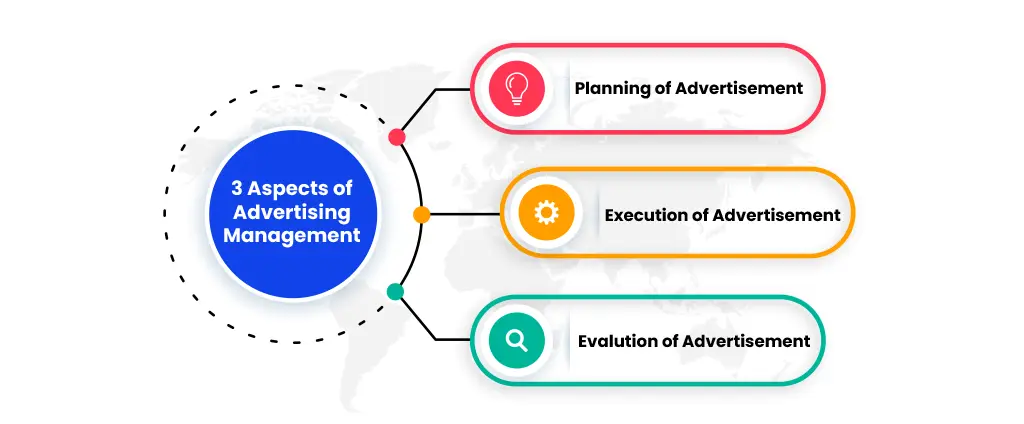
An Overview of Advertising Management
Before heading into the processes of advertising management, let’s understand advertising management in brief. The advertising management department has the responsibility of handling the entire AD campaign. It includes outlining the framework and budget for the advertisement, developing it, choosing the appropriate channels to broadcast the advertisement, building and managing the ADs budget, tracking the statistics of your advertising, and so on.
Advertising management ensures that the objectives and ideas are delivered to the audience appropriately. Ensuring that the advertisement is aligned with the company’s guidelines and policies. Keeping an eye on the positive response and the Return on Investment (ROI) from the advertisement.
Advertising Management is majorly divided into three different processes, which will be discussed further in detailed form in this blog.
- Planning: A best and strategized outline and framework is what is needed to execute a successful AD campaign. The first and foremost process of advertising is that an advertisement needs to be planned properly. Therefore, the advertising management department needs to come up with a peculiar idea that is also aligned with the trendy topics. This process also involves knowing your targeted audience (TG), since they are the ones who will help you to boost the engagement of your brand, product, or service. This kind of planning can give the company a positive response, excellent engagement, and a profitable return on investment (ROI).
- Executing: After curating a strong framework for your advertising campaign. The next step is the execution of the advertisement campaign. For the execution of your advertising campaign, it is important to channel the medium of your advertisement and other sources such as television, radio, newspaper, billboards, or any other medium. It also includes the content creation of your advertising campaigns.
- Evaluation: The evaluation of the advertising campaign is the last and final step of the advertising process. It involves managing and analyzing the effects of the advertising campaign on the targeted audience. The statistics of the AD campaign also help the organization in curating the plans and strategies for future AD campaigns. This evaluation of the AD campaigns helps the advertisement management department to improve its way of strategizing and planning.
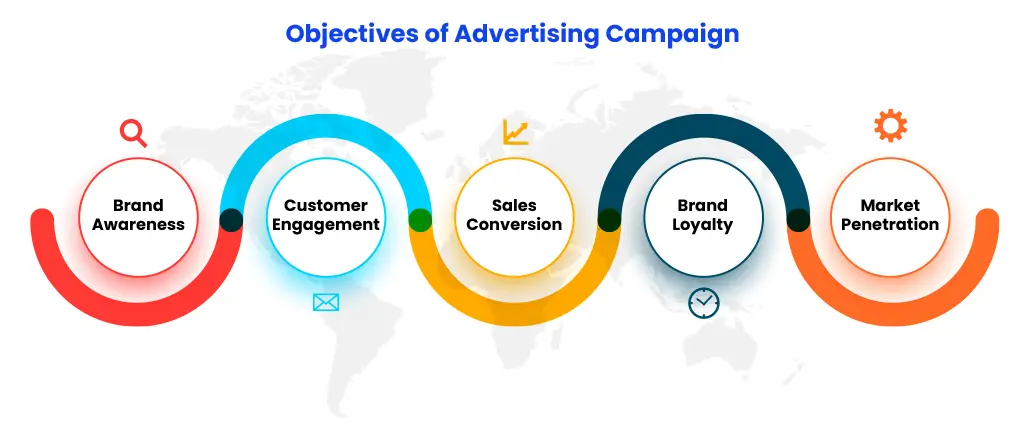 Advertisement Campaigns Planning
Advertisement Campaigns Planning
To make any task successful, it is important to curate a proper plan with a good strategy. Similarly, to run any AD campaign successfully and to achieve a positive return on investment (ROI), a strong and well-planned strategy is needed. An AD campaign plan acts like a blueprint for the business firm in finding its targeted audience (TG), articulating the goals, and deciding suitable channels for the advertising campaign.
Setting Advertisement Objectives
Before executing an AD campaign setting the proper objectives is necessary. These objectives must be aligned with the company’s policies and marketing goals.
There are several common objectives that need to be followed, including:
- Brand Awareness: The main objective of any AD campaign is to introduce the targeted audience (TG) to the products or services that are offered by the organizational firm. Here the targeted audience (TG) can be referred to both your existing as well as your new followers or audience.
- Consumer Engagement: Customer engagement is something that plays a crucial part in boosting the return on investment (ROI) of your AD campaigns. Therefore besides, awarding your audience with the brand objectives or goals, encouraging them into your brand or product/service through various mediums such as social media platforms, product trials, free gift schemes, and so on.
- Sales Conversion: You can also run a special deals scheme or limited period deals to ignite the direct purchasing and sales conversions of your products, services, and brand among the targeted audience (TG).
- Brand Loyalty: Building good relations with your targeted audience (TG) is very crucial. This process helps in increasing business ROI and promoting brand advocacy.
- Market Penetration: Expanding the products or goods in the new marketplace can be a risk-taking factor. However, this risk-taking factor can give you fruitful outcomes and can lead you toward an increased share in the marketplace.
These are a few objectives of an advertising campaign that will guide you in delivering the main message of your brand, making informed and data-oriented decisions, and selecting the suitable medium of channelizing to promote your brand awareness.
Market Research and Audience Segmentation
The next step in the execution of a successful AD campaign is good market research and audience segmentation. Every advertising campaign is not for everyone and isn’t praised by all types of people. Therefore, it is important for the AD management department to have good research and analytical skills. And this process involves understanding the preferences, needs, and behaviors of different consumer groups. The deep understanding of the target audience allows for the creation of personalized, relevant messages that resonate with consumers.
There are several key aspects of market research and audience segmentation:
- Demographics: The first key aspect is analyzing the demographics of the targeted audience (TG) which includes age, gender, income, education level, and occupation.
- Geographics: The popularity of the brand, service, or product depends on the geographical location of the targeted audience (TG). This process also called location-based segmentation includes region, city, or country.
- Psychographics: The brand popularity can also be determined by the psychographic aspects of the targeted audience (TG) which includes lifestyle choices, values, the field of interests, and behavioral attitudes.
- Behaivourial: The brand or product growth of a product depends on behaivoural aspects of the targeted audience (TG) that include consumer buying habits, brand loyalty, and purchasing patterns.
Remember, your AD has the power to uplift your brand awareness and organization’s ROI, therefore it is very crucial to do proper market research. Therefore, the more precisely an audience is defined, the more likely the advertising campaign will be successful. Modern advertising management tools leverage data analytics to build detailed customer profiles and help businesses create targeted ads for specific segments.
Budgeting and Resources Allocation
After outlining the framework of the AD campaign, setting the objectives of the campaign, and articulating the market research and audience segments, the next step is to set a suitable budget and allocate proper resources to the teams. Budgeting in advertising management is crucial because it determines the resources available for creative development, media buying, and campaign tracking.
There is a wide range of methodologies for setting an advertising budget:
- Sales Percentage: It is a situation where the company allots a particular percentage of its total sales to the advertising management department to execute the AD campaign.
- Objective & Task Method: This is another strategy to allocate the budget and resources to the advertising management department for the execution of the AD campaign. It is a situation where the budget is decided on the basis of the company’s set objectives and needed resources. It is a flexible approach where the company plans the budget and allocates resources on the basis of the tasks and goals of the advertising management department.
- Competitive Parity: Since the name says itself, this approach is based on the budget and resources of the competitors. It means setting a budget and resource allocation on the basis of the competitor’s spending amount to stay in the competition in the marketplace.
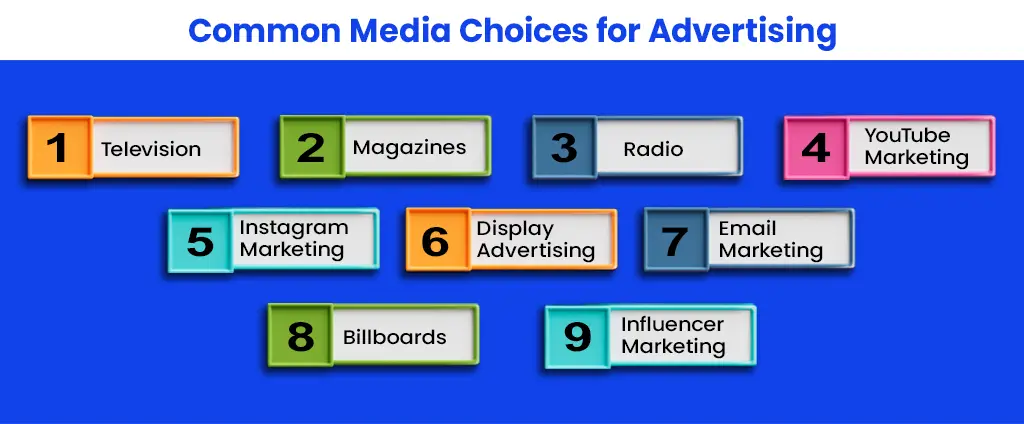
Media Planning and Channelizing the Medium
The next step of advertising management is to plan suitable media and channel the proper medium for advertising your product or service campaign. One of the most important decisions in advertising management is choosing the right media channels to reach the target audience. Media planning involves selecting the best platforms (television, radio, print, digital, etc.) based on factors like audience reach, demographics, and the nature of the product being advertised.
Common media choices include:
- Traditional Media: The advertising agency or management has been working with the help of traditional mediums for an extended period of time. These conventional media sources include Television (TV), radio, newspapers, and magazines. These sources have been used by the common public from ancient times to till date.
- Digital Media: Digital media is a modern-day source of advertising that spreads information 2-3X faster than traditional media. Therefore, the advertising management department usually incorporates the digital media as much as to brand their products and services. They pitch their products on different social media platforms that include Facebook, Instagram, YouTube, WhatsApp, Threads, and so on. They also take help from other digital media sources, including Websites, Search Engines, Email Marketing, Display Ads, and many other digital mediums to showcase their products, services, and AD campaigns.
- Out-of-Home Media: Another medium of advertising is out-of-home media, which includes Billboards, Hoardings, Transit Ads, and Digital Signage. These media sources are very helpful in promoting the products and services information to the mass public.
- Influencer Marketing: Audiences usually follow or get influenced by their favourite celebrity or face. And therefore, media houses or advertising management contact social media influencers or famous celebrities to promote their brand, services, products, and so on. For example, Byju took the face of Shah Rukh Khan to promote the product and services among their targeted audience (TG) which is students, helping the brand in gaining so many admissions. Another example of influencer marketing is Maggi, with the help of Amitabh Bachchan and Madhuri Dixit Nene, Nestle’s Maggi became so famous among the public, helping them reach a high sales rate even though its price has fluctuated numerous times. This shows how people can be influenced by their favourite personalities and purchase the products or services.
Hence, choosing the right media and planning an accurate medium plays an important role in advertising. This is something that can boost your sales or end you up with a loss. That’s it is the responsibility of the media houses or advertising management departments to keep an eye on the trending media platforms in order to boost their reach among the common public.
Creative Strategy & Message Development
A creative and message-delivering AD can also help the advertising management department in reaching to a mass public. Most advertising management adds creativity to the ADs by message-giving concepts that tell the story or concept of your brand or products, some kind of jingles, or songs to attract the attention of the public or targeted audience (TG).
Crucial Elements To Keep In Mind Before Planning A Creative Brand Strategy:
- Unique Selling Proposition (USP): The most crucial element of a brand is its Unique Selling Proposition (USP). As the name suggests, it refers to that unique quality that makes the brand, product, or service stand out from the other competitive brands with the same products or services.
- For Instance: Maggi and Yippee are two different instant noodles from two different types of brands that are Nestle and ITC, respectively. However, both noodles have their own group of buyers., Maggi has a USP of being quickly made in 2 minutes, whereas the USP of the Yippe is the round shape that makes it a longer and non-sticky noodle.
- Emotional Appeal: The targeted audience is usually attracted to or remembers the Ads that deliver emotional appeal. Since people get more influenced when their emotions get pinched.
- For Example: In 2011, Havells came up with an emotional yet creative storyline. In this AD, a woman used to live near a construction side with her boy. One day, the boy noticed that her mother was struggling to make rotis on the fire. Thus, he made a tong out of the Havells wires. This AD wasn’t the epitome of emotions, but AD also gained immense popularity among the audience, and the Tagline “wires that don’t catch fire” became famous.
- Call to Action (CTA): The “Call to Action” is the final process for a brand. It is something that helps the audience in taking major actions such as purchasing, visiting the brand website, and so on.
Thus, the advertising management department needs to understand consumer psychology and objectives before incorporating creativity into it. Once the brands and advertising management department understand the idea, the creative storyline will speak for itself about the brand among the targeted audience.
Advertising Actions
Once the advertising management department is done with planning the AD strategy. The next step in advertising management is its action. This step will include the implementation of the plans and strategy into the ADs to promote the brand, product, or service.
AD Creation & Its Production
Since the advertising management department has a complete strategy and a creative storyline to attract the audience. The next is to create and produce the AD. For that, the advertising team needs to contact the production team and produce the AD according to the mediums or channels in which they gonna show the AD. However, this process will include some other departments, such as copywriters, graphic designers, video production teams, and digital content creation teams.
- For Example: Stayfree has different types of storylines or music for the TV, Visual-based channels, or any other medium in which the AD can be seen by the audience. On the other hand, for audio-based channels, such as Spotify. They use some other kind of music and storyline to attract the audience.
Media Buying & Distribution
After the AD creation and production, the next step is to buy the space or time for distributing the advertisement. It is the responsibility of the advertising managers to purchase the time or space for the ADs so that they can be executed on different media platforms. This process needs a proper negotiation over the budget, time, and place for the advertisement.
Since the modern era has digitalized, media buying often includes the following things:
- Programmatic Advertising: This is one of the modern approach of buying digital Ad space with the help of algorithms and real-time bidding.
- Social Media Ads: This is another new-era approach to promote the content or display banner ads on platforms like Facebook, Instagram, or LinkedIn. The company just need to pay for the brand, product or service promotion.
- Search Engine Marketing (SEM): This approach involves paying for ad placements on search engine result pages (e.g., Google Ads).
Effective media buying ensures that the ad reaches the target audience at the right time and place while adhering to the campaign budget.
AD Campaign & Monitoring
After launching the Ad campaign, monitoring the Ad is very crucial. It is important to keep an eye on the statistics of likes, reach, engagement, conversions, or ROI to make adjustments for boosting the AD more efficiently.
Nowadays, there are many tools to monitor or analyze the growth and engagement of ADs. Company can incorporate tools and techniques such as Google Analytics and so on to keep an insights of the advertisement. This optimization sometimes involves A/B testing, adjusting bid for maximizing the reach and relocation of the AD budget to uplift the ROI of the company.
Creative Agencies & Partners Collaborations
Most of the companies collaborate with creative agencies and renowned partners to develop and execute the Advertisement. Effective collaboration with agencies ensures that the campaign is executed efficiently and stays on track. It also allows businesses to tap into the agency’s specialized knowledge, whether it's in digital marketing, video production, or influencer partnerships.
Advertising Effects and Evaluation
After planning and executing the advertisement, it is important to keep an eye on the after-effects of the advertising campaign. The evaluation of an ad campaign is very crucial since it acts as a report and help the advertisement management department to know the performance of a certain advertisement campaign run by an organization. This is a critical step in determining whether the campaign has achieved its objectives and providing insights for future campaigns.
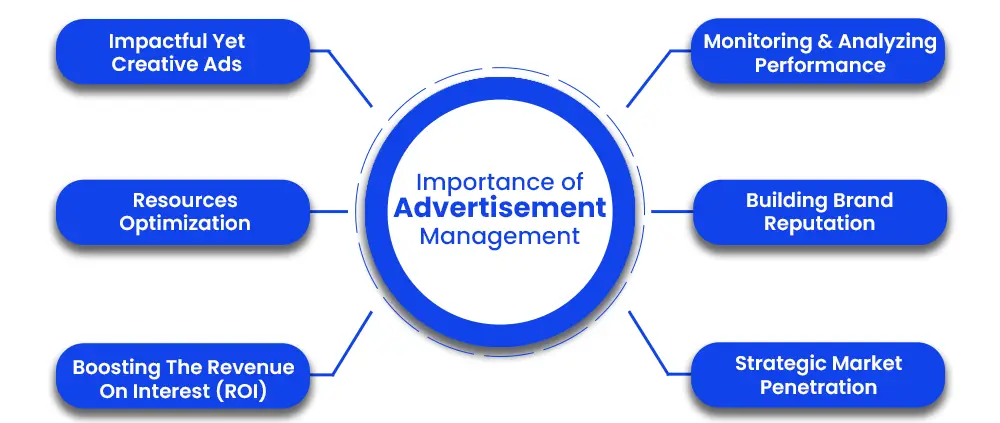
Importance of Advertising Management
Advertising Management plays an important role in promoting the brand, products, and services provided by the organization. Here are a few reasons why it is important to make an impactful advertisement.
- Impactful Yet Creative Ads: The main purpose of making an advertisement is to grab the attention of the common public. Therefore, it is important to make effective yet creative ads.
The advertisement agency must emphasize on making powerful jingles or storylines to make the advertisement effective and eye-catching.
- Resources Optimization: The resources optimization is also very important while planning or executing the advertisement. It is the major responsibility of the advertisement or marketing manager to keep an eye on the resource allocation. They must ensure that each of the resources are optimally allocated and used accordingly the advertisement.
- Boosting The Revenue On Interest (ROI): The final output of any task is its revenue on interest (ROI) that means how much profit an organization make with the help of an advertisement. Therefore, the advertisement management department ensures that all the advertisements must be made according to the customer’s or targeted audience needs and preferences. This strategy helps the company in earning positive outcomes and high sales revenue.
- Monitoring & Analyzing Performance: Monitoring and analyzing the performance of an advertising campaign is very important. The analysis of an advertisement helps in monitoring the performance of the advertisement. After analyzing the performance, the advertisement management department must work on adjustments to improve the effectiveness of the ad and to enhance the revenue of the advertisement.
- Building Brand Reputation: An effective advertisement can help the organization in gaining new customers and an audience. Since the advertisement showcases the brand motive and storyline, it helps in building the brand and obtaining brand and product recognition among the targeted audience. It also helps in building trust among the buyer community.
- Strategic Market Penetration: An effective advertisement helps the brand in standing out from the crowd. A strong and effective marketing strategy, storyline and jingles can leave a long lasting impression into the audience mind.
- For Example: In 2012, Idea came up with a jingle that was “Hello Honey Bunny” which is still in the audience’s minds. Even this advertisement had a very strong message about the Pan-India presence and talked about the strong network of Idea Sim.
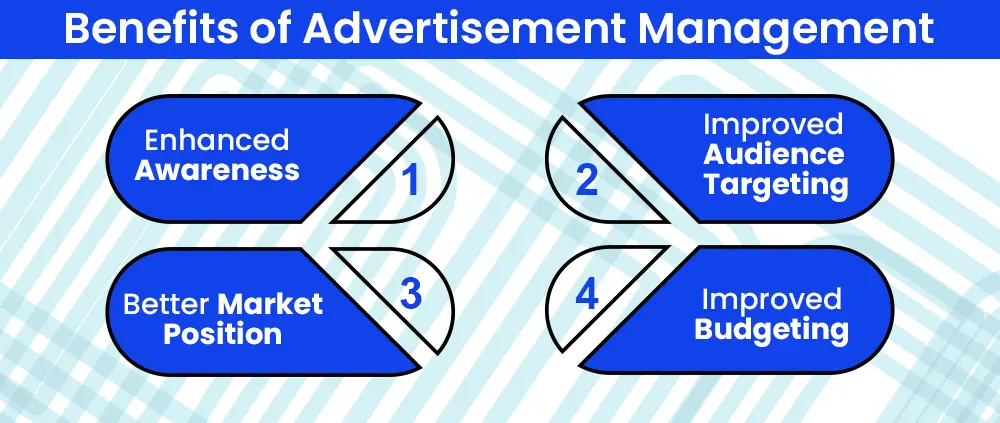
Benefits of Advertising Management
Having an advertisement management department in an organization. As it can help the company with a wide range of facilities, which will be discussed in this section:
- Enhanced Brand Awareness: The advertisement management team helps connect with the audience and boost brand awareness and reach among the targeted audience. It also helps you in spreading awareness about the products and services among the audience.
- Better Market Position: The main objective of advertisement management is to make effective ad plans. These strategies and ad plans will help the company stand out from the crowd & improve your brand awareness and market position. Depending on your ad and goals, you can set yourself apart from your competitors and improve your market position.
- Improved Audience Targeting: The advertisement management department helps in searching the audience targeting. The advertisement management department of an organizational firm need to do thorough research on the preferred topics and demographics to publish the ads accordingly. As you figure out which ads to publish, you can do more research on your audience, including their preferences and demographics.
- Improved Budgeting: The advertisement management department needs to work on the budgets to ensure a seamless and streamlined ad production and execution of the ads. With a solid advertising plan, you can spend your advertising budget on campaigns that drive results.
Let’s Wrap It Up!
Effective advertising management is very important for any business to be successful in a competitive market. With careful planning, execution, and evaluation of the advertising campaign, companies can ensure that their messages reach the right audience, engage them effectively, and drive desired outcomes. Whether it is brand awareness, sales generation, or customer loyalty, advertising management provides the tools and strategies to achieve these objectives.
With the rapid evolution of digital media, advertising management has become more dynamic and data-driven than ever before. With new technologies, real-time optimization of campaigns, and continuous measurement of performance, businesses can stay ahead of the curve and continue to thrive in an increasingly competitive landscape.
FAQs (Frequently Asked Questions)
The actions of the advertising refer to the activities through which the advertisers can communicate or interact with the audience. For instance, any advertiser's hyperlink or website link helps the customer's viewers to visit the website directly or any contact details that connect the customers directly to the website. This can help in boosting the engagement of the website or brand.
Advertising has 3 primary objectives that are to inform, to persuade, and to remind the audience. The goal of advertising is to inform and educate people about the launched or existing services, brands, or products to create awareness and boost engagement.
Here are the listed ways through which you can plan an effective advertisement:
- Step-1: You can create an outline or framework for your advertisement.
- Step-2: After outlining the framework, a budget for the execution of the advertisement is required.
- Step-3: Knowing your targeted audience is also very important as your audience is the one who decides whether your advertisement is a hit or flop.
- Step-4: Select your medium, like whether the advertisements will be run online or offline mediums such as television, radio, social media platforms, newspapers, billboards, and so on.
- Step-5: After the development of the advertisement, the very next step is to develop and publish the advertisement.
- Step-6: After publishing the advertising, it is very important to track the metrics of the advertisement to improve its performance.
- Step-7: Evaluation of the results is also important to review the overall engagement of your advertisement.
- Step-8: Once your advertisement is executed well, look forward to the adjustments for future campaigns
The 5 functions of advertising are as follows:
- Function- 1: To Inform
- Function- 2: To Influence
- Function- 3: To Increase Salience
- Function- 4: To Add Value
- Function- 5: To Put Extra Effort In Any AD Campaigns
The effect of the ads refers to the impact of how much the audience or consumers influence them. It is also important to know the preferences of your TG to increase your engagement.

3 Years of Experience / Narrator
With 3 years of experience in content writing and copywriting and keen interest in voiceover and scripting, I, Isha Adhikari, am passionate about content creation and narration.
Every query is essential.
Our team of experts, or experienced individuals, will answer it within 24 hours.
Recommended for you
Tired of dealing with call centers!
Get a professional advisor for Career!
LIFETIME FREE
Rs.1499(Exclusive offer for today)

Pooja
MBA 7 yrs exp

Sarthak
M.Com 4 yrs exp

Kapil Gupta
MCA 5 yrs exp
or



Career Finder
(Career Suitability Test)
Explore and Find out your Most Suitable Career Path. Get Started with our Career Finder Tool Now!
ROI Calculator
Find out the expected salary, costs, and ROI of your chosen online university with our free calculator.
